Human Cloning Assignment PDF
VerifiedAdded on 2021/10/30
|6
|1523
|71
AI Summary
Contribute Materials
Your contribution can guide someone’s learning journey. Share your
documents today.
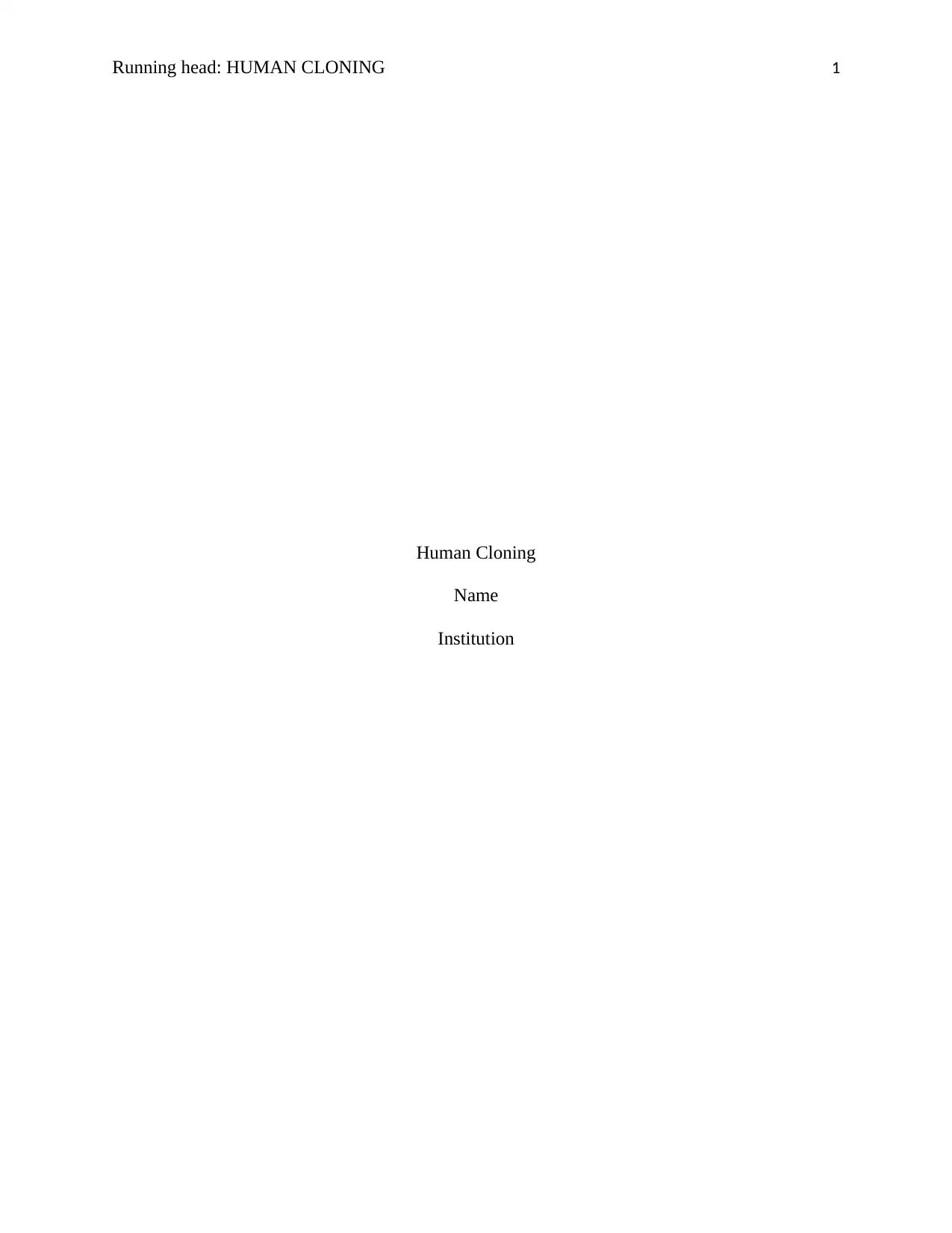
Running head: HUMAN CLONING 1
Human Cloning
Name
Institution
Human Cloning
Name
Institution
Secure Best Marks with AI Grader
Need help grading? Try our AI Grader for instant feedback on your assignments.
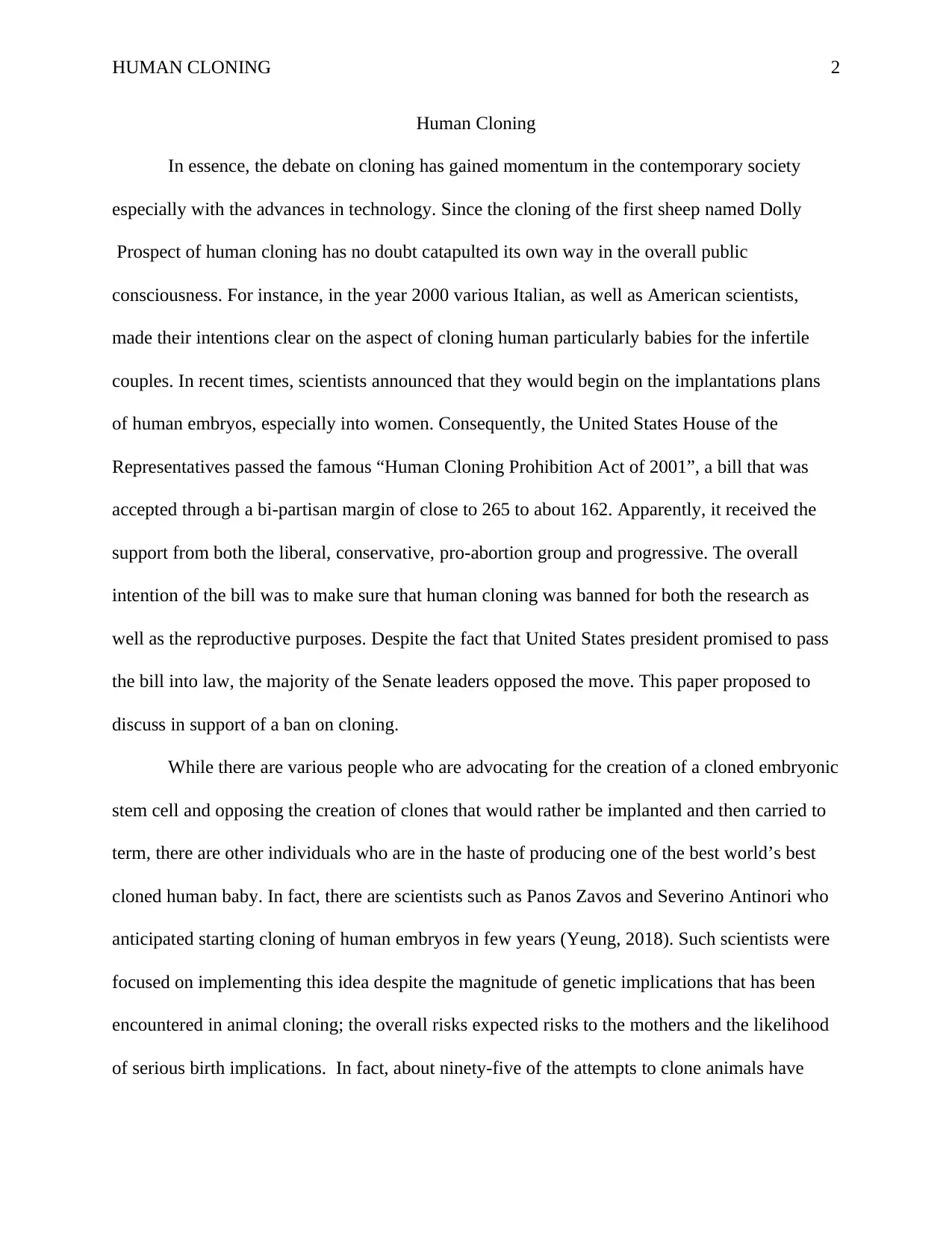
HUMAN CLONING 2
Human Cloning
In essence, the debate on cloning has gained momentum in the contemporary society
especially with the advances in technology. Since the cloning of the first sheep named Dolly
Prospect of human cloning has no doubt catapulted its own way in the overall public
consciousness. For instance, in the year 2000 various Italian, as well as American scientists,
made their intentions clear on the aspect of cloning human particularly babies for the infertile
couples. In recent times, scientists announced that they would begin on the implantations plans
of human embryos, especially into women. Consequently, the United States House of the
Representatives passed the famous “Human Cloning Prohibition Act of 2001”, a bill that was
accepted through a bi-partisan margin of close to 265 to about 162. Apparently, it received the
support from both the liberal, conservative, pro-abortion group and progressive. The overall
intention of the bill was to make sure that human cloning was banned for both the research as
well as the reproductive purposes. Despite the fact that United States president promised to pass
the bill into law, the majority of the Senate leaders opposed the move. This paper proposed to
discuss in support of a ban on cloning.
While there are various people who are advocating for the creation of a cloned embryonic
stem cell and opposing the creation of clones that would rather be implanted and then carried to
term, there are other individuals who are in the haste of producing one of the best world’s best
cloned human baby. In fact, there are scientists such as Panos Zavos and Severino Antinori who
anticipated starting cloning of human embryos in few years (Yeung, 2018). Such scientists were
focused on implementing this idea despite the magnitude of genetic implications that has been
encountered in animal cloning; the overall risks expected risks to the mothers and the likelihood
of serious birth implications. In fact, about ninety-five of the attempts to clone animals have
Human Cloning
In essence, the debate on cloning has gained momentum in the contemporary society
especially with the advances in technology. Since the cloning of the first sheep named Dolly
Prospect of human cloning has no doubt catapulted its own way in the overall public
consciousness. For instance, in the year 2000 various Italian, as well as American scientists,
made their intentions clear on the aspect of cloning human particularly babies for the infertile
couples. In recent times, scientists announced that they would begin on the implantations plans
of human embryos, especially into women. Consequently, the United States House of the
Representatives passed the famous “Human Cloning Prohibition Act of 2001”, a bill that was
accepted through a bi-partisan margin of close to 265 to about 162. Apparently, it received the
support from both the liberal, conservative, pro-abortion group and progressive. The overall
intention of the bill was to make sure that human cloning was banned for both the research as
well as the reproductive purposes. Despite the fact that United States president promised to pass
the bill into law, the majority of the Senate leaders opposed the move. This paper proposed to
discuss in support of a ban on cloning.
While there are various people who are advocating for the creation of a cloned embryonic
stem cell and opposing the creation of clones that would rather be implanted and then carried to
term, there are other individuals who are in the haste of producing one of the best world’s best
cloned human baby. In fact, there are scientists such as Panos Zavos and Severino Antinori who
anticipated starting cloning of human embryos in few years (Yeung, 2018). Such scientists were
focused on implementing this idea despite the magnitude of genetic implications that has been
encountered in animal cloning; the overall risks expected risks to the mothers and the likelihood
of serious birth implications. In fact, about ninety-five of the attempts to clone animals have
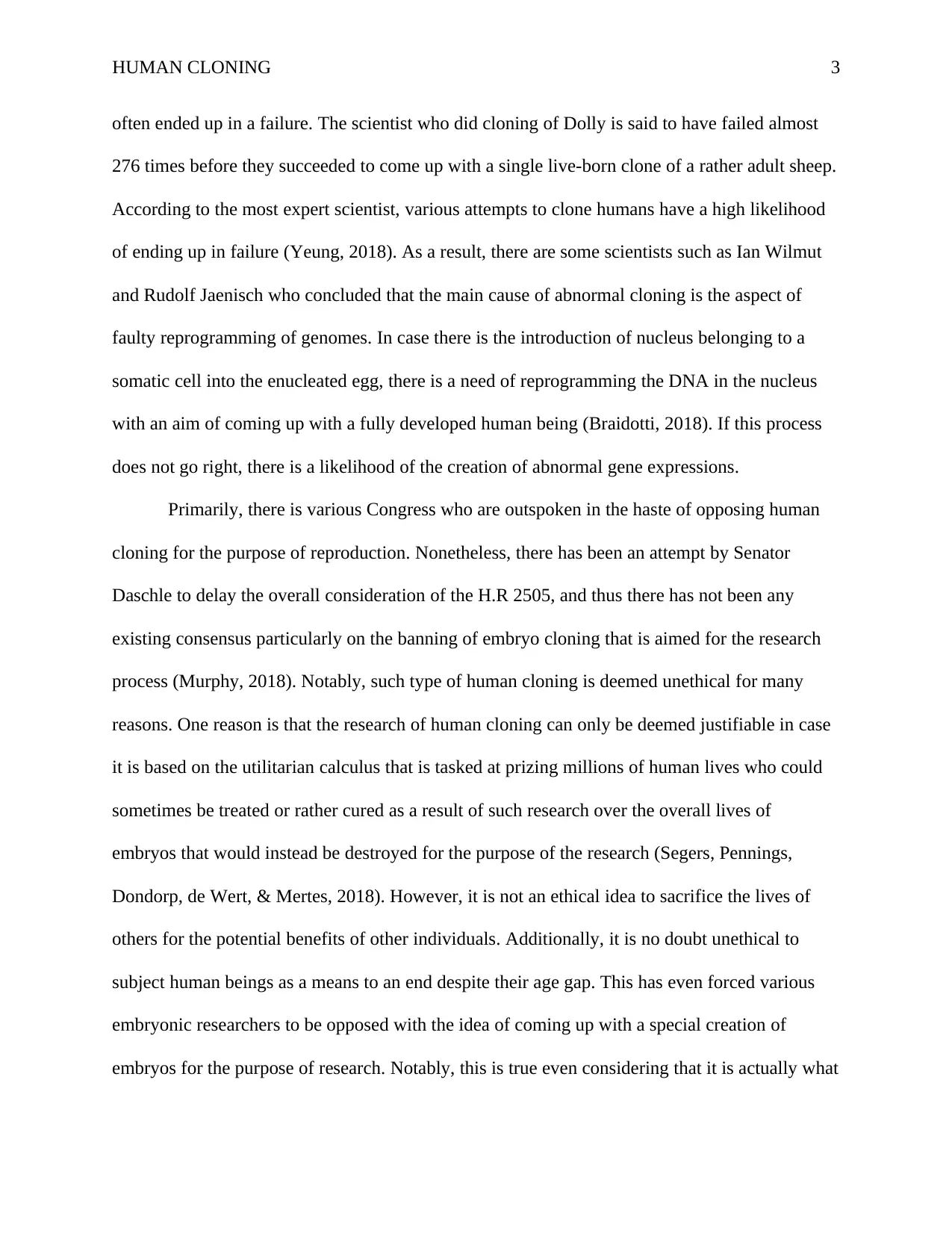
HUMAN CLONING 3
often ended up in a failure. The scientist who did cloning of Dolly is said to have failed almost
276 times before they succeeded to come up with a single live-born clone of a rather adult sheep.
According to the most expert scientist, various attempts to clone humans have a high likelihood
of ending up in failure (Yeung, 2018). As a result, there are some scientists such as Ian Wilmut
and Rudolf Jaenisch who concluded that the main cause of abnormal cloning is the aspect of
faulty reprogramming of genomes. In case there is the introduction of nucleus belonging to a
somatic cell into the enucleated egg, there is a need of reprogramming the DNA in the nucleus
with an aim of coming up with a fully developed human being (Braidotti, 2018). If this process
does not go right, there is a likelihood of the creation of abnormal gene expressions.
Primarily, there is various Congress who are outspoken in the haste of opposing human
cloning for the purpose of reproduction. Nonetheless, there has been an attempt by Senator
Daschle to delay the overall consideration of the H.R 2505, and thus there has not been any
existing consensus particularly on the banning of embryo cloning that is aimed for the research
process (Murphy, 2018). Notably, such type of human cloning is deemed unethical for many
reasons. One reason is that the research of human cloning can only be deemed justifiable in case
it is based on the utilitarian calculus that is tasked at prizing millions of human lives who could
sometimes be treated or rather cured as a result of such research over the overall lives of
embryos that would instead be destroyed for the purpose of the research (Segers, Pennings,
Dondorp, de Wert, & Mertes, 2018). However, it is not an ethical idea to sacrifice the lives of
others for the potential benefits of other individuals. Additionally, it is no doubt unethical to
subject human beings as a means to an end despite their age gap. This has even forced various
embryonic researchers to be opposed with the idea of coming up with a special creation of
embryos for the purpose of research. Notably, this is true even considering that it is actually what
often ended up in a failure. The scientist who did cloning of Dolly is said to have failed almost
276 times before they succeeded to come up with a single live-born clone of a rather adult sheep.
According to the most expert scientist, various attempts to clone humans have a high likelihood
of ending up in failure (Yeung, 2018). As a result, there are some scientists such as Ian Wilmut
and Rudolf Jaenisch who concluded that the main cause of abnormal cloning is the aspect of
faulty reprogramming of genomes. In case there is the introduction of nucleus belonging to a
somatic cell into the enucleated egg, there is a need of reprogramming the DNA in the nucleus
with an aim of coming up with a fully developed human being (Braidotti, 2018). If this process
does not go right, there is a likelihood of the creation of abnormal gene expressions.
Primarily, there is various Congress who are outspoken in the haste of opposing human
cloning for the purpose of reproduction. Nonetheless, there has been an attempt by Senator
Daschle to delay the overall consideration of the H.R 2505, and thus there has not been any
existing consensus particularly on the banning of embryo cloning that is aimed for the research
process (Murphy, 2018). Notably, such type of human cloning is deemed unethical for many
reasons. One reason is that the research of human cloning can only be deemed justifiable in case
it is based on the utilitarian calculus that is tasked at prizing millions of human lives who could
sometimes be treated or rather cured as a result of such research over the overall lives of
embryos that would instead be destroyed for the purpose of the research (Segers, Pennings,
Dondorp, de Wert, & Mertes, 2018). However, it is not an ethical idea to sacrifice the lives of
others for the potential benefits of other individuals. Additionally, it is no doubt unethical to
subject human beings as a means to an end despite their age gap. This has even forced various
embryonic researchers to be opposed with the idea of coming up with a special creation of
embryos for the purpose of research. Notably, this is true even considering that it is actually what
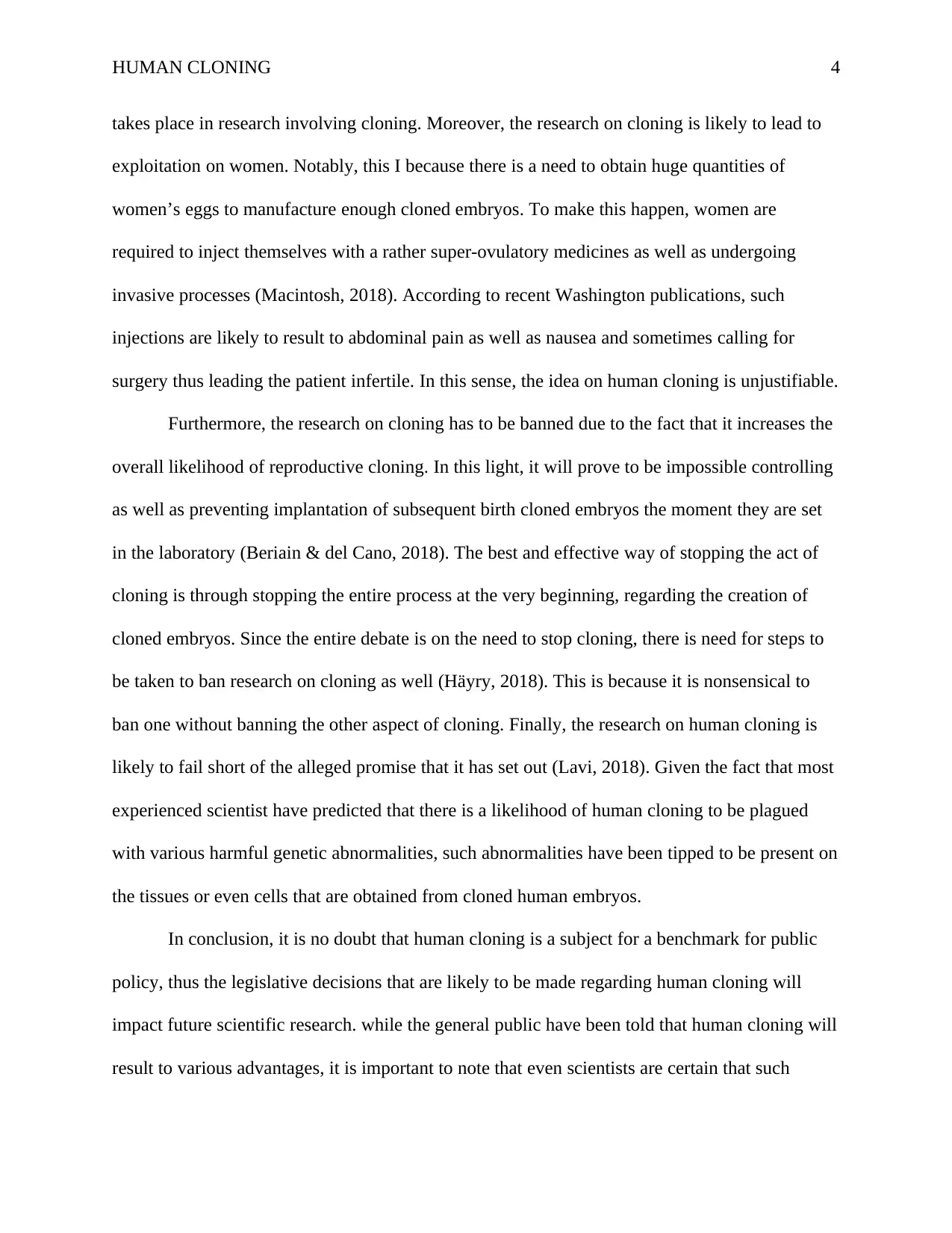
HUMAN CLONING 4
takes place in research involving cloning. Moreover, the research on cloning is likely to lead to
exploitation on women. Notably, this I because there is a need to obtain huge quantities of
women’s eggs to manufacture enough cloned embryos. To make this happen, women are
required to inject themselves with a rather super-ovulatory medicines as well as undergoing
invasive processes (Macintosh, 2018). According to recent Washington publications, such
injections are likely to result to abdominal pain as well as nausea and sometimes calling for
surgery thus leading the patient infertile. In this sense, the idea on human cloning is unjustifiable.
Furthermore, the research on cloning has to be banned due to the fact that it increases the
overall likelihood of reproductive cloning. In this light, it will prove to be impossible controlling
as well as preventing implantation of subsequent birth cloned embryos the moment they are set
in the laboratory (Beriain & del Cano, 2018). The best and effective way of stopping the act of
cloning is through stopping the entire process at the very beginning, regarding the creation of
cloned embryos. Since the entire debate is on the need to stop cloning, there is need for steps to
be taken to ban research on cloning as well (Häyry, 2018). This is because it is nonsensical to
ban one without banning the other aspect of cloning. Finally, the research on human cloning is
likely to fail short of the alleged promise that it has set out (Lavi, 2018). Given the fact that most
experienced scientist have predicted that there is a likelihood of human cloning to be plagued
with various harmful genetic abnormalities, such abnormalities have been tipped to be present on
the tissues or even cells that are obtained from cloned human embryos.
In conclusion, it is no doubt that human cloning is a subject for a benchmark for public
policy, thus the legislative decisions that are likely to be made regarding human cloning will
impact future scientific research. while the general public have been told that human cloning will
result to various advantages, it is important to note that even scientists are certain that such
takes place in research involving cloning. Moreover, the research on cloning is likely to lead to
exploitation on women. Notably, this I because there is a need to obtain huge quantities of
women’s eggs to manufacture enough cloned embryos. To make this happen, women are
required to inject themselves with a rather super-ovulatory medicines as well as undergoing
invasive processes (Macintosh, 2018). According to recent Washington publications, such
injections are likely to result to abdominal pain as well as nausea and sometimes calling for
surgery thus leading the patient infertile. In this sense, the idea on human cloning is unjustifiable.
Furthermore, the research on cloning has to be banned due to the fact that it increases the
overall likelihood of reproductive cloning. In this light, it will prove to be impossible controlling
as well as preventing implantation of subsequent birth cloned embryos the moment they are set
in the laboratory (Beriain & del Cano, 2018). The best and effective way of stopping the act of
cloning is through stopping the entire process at the very beginning, regarding the creation of
cloned embryos. Since the entire debate is on the need to stop cloning, there is need for steps to
be taken to ban research on cloning as well (Häyry, 2018). This is because it is nonsensical to
ban one without banning the other aspect of cloning. Finally, the research on human cloning is
likely to fail short of the alleged promise that it has set out (Lavi, 2018). Given the fact that most
experienced scientist have predicted that there is a likelihood of human cloning to be plagued
with various harmful genetic abnormalities, such abnormalities have been tipped to be present on
the tissues or even cells that are obtained from cloned human embryos.
In conclusion, it is no doubt that human cloning is a subject for a benchmark for public
policy, thus the legislative decisions that are likely to be made regarding human cloning will
impact future scientific research. while the general public have been told that human cloning will
result to various advantages, it is important to note that even scientists are certain that such
Secure Best Marks with AI Grader
Need help grading? Try our AI Grader for instant feedback on your assignments.
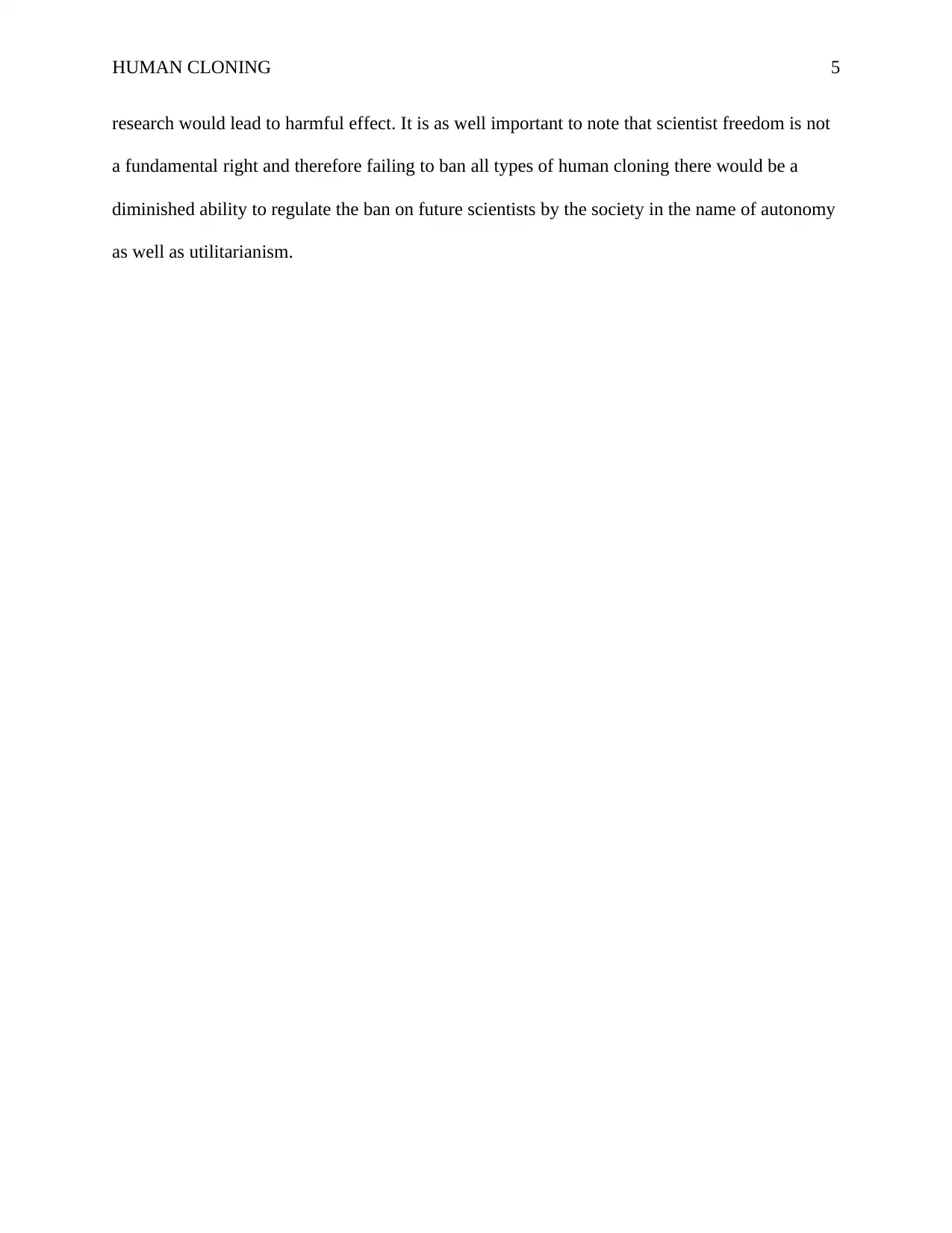
HUMAN CLONING 5
research would lead to harmful effect. It is as well important to note that scientist freedom is not
a fundamental right and therefore failing to ban all types of human cloning there would be a
diminished ability to regulate the ban on future scientists by the society in the name of autonomy
as well as utilitarianism.
research would lead to harmful effect. It is as well important to note that scientist freedom is not
a fundamental right and therefore failing to ban all types of human cloning there would be a
diminished ability to regulate the ban on future scientists by the society in the name of autonomy
as well as utilitarianism.
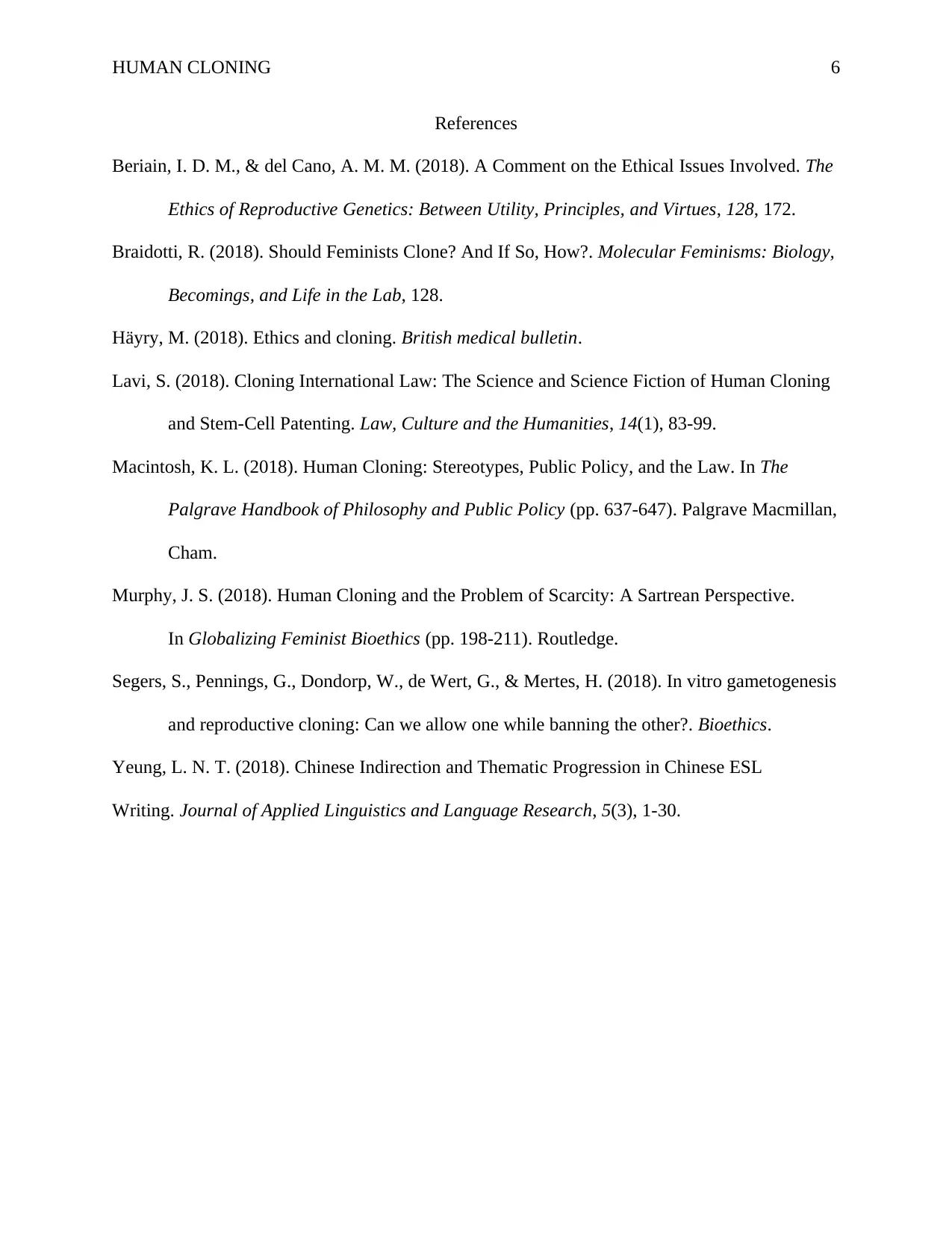
HUMAN CLONING 6
References
Beriain, I. D. M., & del Cano, A. M. M. (2018). A Comment on the Ethical Issues Involved. The
Ethics of Reproductive Genetics: Between Utility, Principles, and Virtues, 128, 172.
Braidotti, R. (2018). Should Feminists Clone? And If So, How?. Molecular Feminisms: Biology,
Becomings, and Life in the Lab, 128.
Häyry, M. (2018). Ethics and cloning. British medical bulletin.
Lavi, S. (2018). Cloning International Law: The Science and Science Fiction of Human Cloning
and Stem-Cell Patenting. Law, Culture and the Humanities, 14(1), 83-99.
Macintosh, K. L. (2018). Human Cloning: Stereotypes, Public Policy, and the Law. In The
Palgrave Handbook of Philosophy and Public Policy (pp. 637-647). Palgrave Macmillan,
Cham.
Murphy, J. S. (2018). Human Cloning and the Problem of Scarcity: A Sartrean Perspective.
In Globalizing Feminist Bioethics (pp. 198-211). Routledge.
Segers, S., Pennings, G., Dondorp, W., de Wert, G., & Mertes, H. (2018). In vitro gametogenesis
and reproductive cloning: Can we allow one while banning the other?. Bioethics.
Yeung, L. N. T. (2018). Chinese Indirection and Thematic Progression in Chinese ESL
Writing. Journal of Applied Linguistics and Language Research, 5(3), 1-30.
References
Beriain, I. D. M., & del Cano, A. M. M. (2018). A Comment on the Ethical Issues Involved. The
Ethics of Reproductive Genetics: Between Utility, Principles, and Virtues, 128, 172.
Braidotti, R. (2018). Should Feminists Clone? And If So, How?. Molecular Feminisms: Biology,
Becomings, and Life in the Lab, 128.
Häyry, M. (2018). Ethics and cloning. British medical bulletin.
Lavi, S. (2018). Cloning International Law: The Science and Science Fiction of Human Cloning
and Stem-Cell Patenting. Law, Culture and the Humanities, 14(1), 83-99.
Macintosh, K. L. (2018). Human Cloning: Stereotypes, Public Policy, and the Law. In The
Palgrave Handbook of Philosophy and Public Policy (pp. 637-647). Palgrave Macmillan,
Cham.
Murphy, J. S. (2018). Human Cloning and the Problem of Scarcity: A Sartrean Perspective.
In Globalizing Feminist Bioethics (pp. 198-211). Routledge.
Segers, S., Pennings, G., Dondorp, W., de Wert, G., & Mertes, H. (2018). In vitro gametogenesis
and reproductive cloning: Can we allow one while banning the other?. Bioethics.
Yeung, L. N. T. (2018). Chinese Indirection and Thematic Progression in Chinese ESL
Writing. Journal of Applied Linguistics and Language Research, 5(3), 1-30.
1 out of 6
Your All-in-One AI-Powered Toolkit for Academic Success.
+13062052269
info@desklib.com
Available 24*7 on WhatsApp / Email
![[object Object]](/_next/static/media/star-bottom.7253800d.svg)
Unlock your academic potential
© 2024 | Zucol Services PVT LTD | All rights reserved.